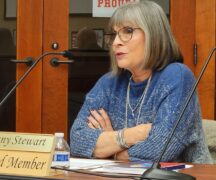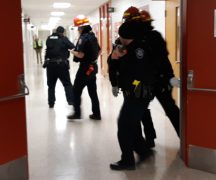By JAN LARSON McLAUGHLIN
BG Independent News
Bowling Green Board of Education voted unanimously Tuesday evening to move ahead on $3.9 million in air conditioning systems that will cool and clean the air in classrooms.
During a special meeting, the board agreed to pursue bids for the mini split air conditioners – regardless of whether or not federal funds will be approved for them.
“We probably need to move ahead with a decision about this project,” rather than wait for funding approval, Superintendent Francis Scruci said to the board.
The mini split systems will provide air conditioning to cool the air and ionization to kill viruses.
“Certainly at this time we could use all the help we could get,” Scruci said.
The district applied for Elementary and Secondary School Emergency Relief funding to pay for a portion of the air conditioning project – with the goal to have the systems in place by next spring.
However, the board learned Tuesday that due to a technicality with the ESSER funding, the applications from all the school districts across Ohio were rejected and asked to resubmit, according to BG City Schools Treasurer Cathy Schuller. So the district recalculated its project and resubmitted it last week.
But the board did not want to wait on word about the ESSER funds before taking the next steps to cool and clean the air in the three city schools that currently don’t have air conditioning – the high school, Conneaut Elementary and Kenwood Elementary.
“We realize how important the air conditioning is,” school board member Ryan Myers said. “The last thing I would want is for us to kick that out, and we’d be looking at fall of 2022.”
Schuller explained the district does have some other “unencumbered and unspoken for” funds that could pay for the air conditioning. The pipeline funds could pay for a portion, with the general fund making up the difference, she said.
Even if the ESSER funds are approved, that $2.5 million would pay a portion of the overall $3.9 million price tag to air condition the three school buildings. The remaining $1.4 million could come from pipeline funds – which are presently at $2.6 million – or carryover in the general fund, Schuller said.
Board member Ginny Stewart asked if the ESSER monies could reimburse those funds if the federal funding is approved for the project.
“There should not be any issues,” Schuller said.
Myers pointed out that if the ESSER funds are not approved for the mini splits, there are plenty other expenses those funds could be used for. At least 20% of ESSER funds must be used to make up for learning losses due to COVID-19, Scruci reminded. Those monies could be used to extend new personnel positions through September 2024, he added.
The board voted unanimously to request quotes for the project, with a deadline for submission of Aug. 30.
By continuing to move forward on the air conditioning of each room by room, the three school buildings could be completed by next June.





